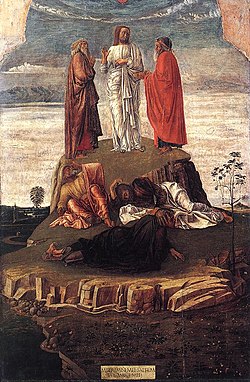
Giovanni Bellini was an Italian Renaissance painter, probably the best known of the Bellini family of Venetian painters. He was raised in the household of Jacopo Bellini, formerly thought to have been his father, but now that familial generational relationship is questioned. An older brother, Gentile Bellini was more highly regarded than Giovanni during his lifetime, but the reverse is true today. His brother-in-law was Andrea Mantegna.
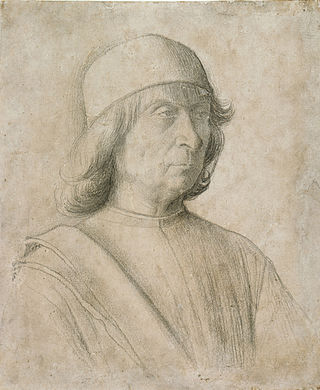
Gentile Bellini was an Italian painter of the school of Venice. He came from Venice's leading family of painters, and at least in the early part of his career was more highly regarded than his younger brother Giovanni Bellini, the reverse of the case today. From 1474 he was the official portrait artist for the Doges of Venice, and as well as his portraits he painted a number of very large subjects with multitudes of figures, especially for the Scuole Grandi of Venice, wealthy confraternities that were very important in Venetian patrician social life.

Jacopo Bellini was one of the founders of the Renaissance style of painting in Venice and northern Italy. His sons Gentile and Giovanni Bellini, and his son-in-law Andrea Mantegna, were also famous painters.

The Gallerie dell'Accademia is a museum gallery of pre-19th-century art in Venice, northern Italy. It is housed in the Scuola della Carità on the south bank of the Grand Canal, within the sestiere of Dorsoduro. It was originally the gallery of the Accademia di Belle Arti di Venezia, the art academy of Venice, from which it became independent in 1879, and for which the Ponte dell'Accademia and the Accademia boat landing station for the vaporetto water bus are named. The two institutions remained in the same building until 2004, when the art school moved to the Ospedale degli Incurabili.

The Museo Correr is a museum in Venice, northern Italy. Located in St. Mark's Square, Venice, it is one of the 11 civic museums run by the Fondazione Musei Civici di Venezia. The museum extends along the southside of the square on the upper floors of the Procuratorie Nuove. With its rich and varied collections, the Museo Correr covers both the art and history of Venice.
The decade of the 1460s in art involved some significant events.
The decade of the 1450s in art involved many significant events, especially in sculpture.

Transfiguration of Christ is a c.1480 oil on panel painting of the Gospel episode the Transfiguration of Jesus by the Italian Renaissance master Giovanni Bellini, now in the Capodimonte Museum in Naples, Italy.
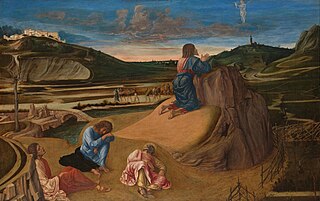
The Agony in the Garden is an early painting by the Italian Renaissance master Giovanni Bellini, who painted it around 1459–65. It is in the National Gallery, London.

Crucifixion is a painting by the Italian Renaissance painter Giovanni Bellini, created around 1455–1460. It is housed in the Museo Correr in Venice.

The Presentation at the Temple is a painting of the Presentation of Jesus at the Temple by the Italian master Giovanni Bellini, dating to c. 1460. It is housed in the Fondazione Querini Stampalia, in Venice, Italy.
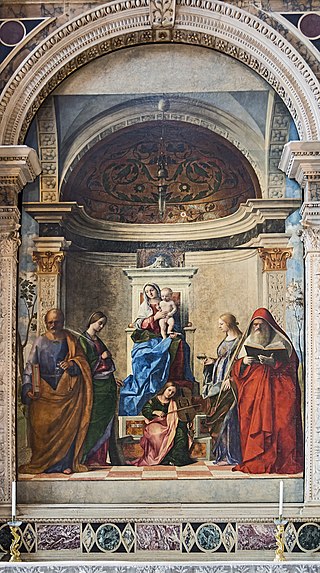
The San Zaccaria Altarpiece is a painting by the Italian Renaissance painter Giovanni Bellini, executed in 1505 and located in the church of San Zaccaria, Venice.
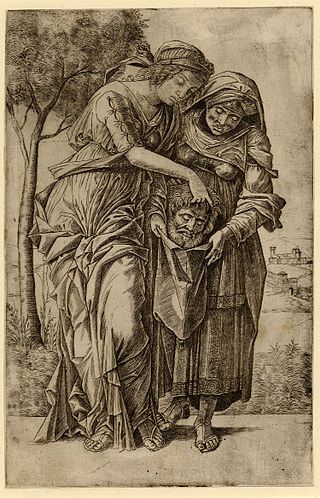
Girolamo Mocetto was an Italian Renaissance painter, engraver, and stained glass designer. He was heavily influenced by Domenico Morone, Giovanni Bellini, Bartolomeo Montagna, Cima da Conegliano, and especially Andrea Mantegna. He is most important as an engraver, and his engravings of the compositions of others are his most successful prints.
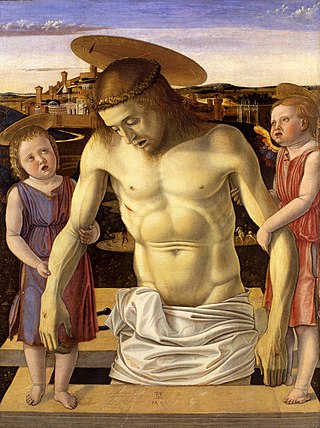
Dead Christ Supported by Two Angels is a painting by Italian Renaissance painter Giovanni Bellini, created around 1460. It is housed in the Museo Correr in Venice.

The Pesaro Altarpiece is an oil on panel painting by Giovanni Bellini, dated to some time between 1471 and 1483. It is considered one of Bellini's first mature works, though there are doubts on its dating and on who commissioned it. The work's technique is not only an early use of oils but also of blue smalt, a by-product of the glass industry. It had already been used in the Low Countries in Bouts' 1455 The Entombment, but this marked smalt's first use in Italian art, twenty years before Leonardo da Vinci used it in Ludovico il Moro's apartments in Milan in 1492. Bellini also uses the more traditional lapis lazuli and azurite for other blues in the work.

The Greek Madonna is a 1460–1470 tempera on panel painting by Giovanni Bellini. It is named after the Greek monograms at top left and top right and after the major influence of Byzantine icons on the painting. The Christ Child holds a golden apple, perhaps referring to the Judgement of Paris and to Mary as the "new Venus".
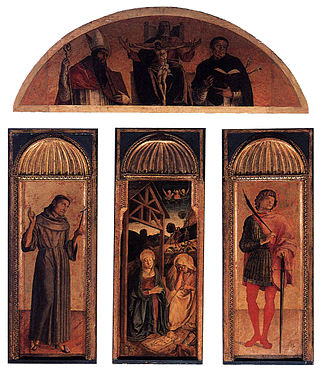
The Nativity Triptych is a 1464–1470 tempera on panel altarpiece by Giovanni Bellini and others. Its central panel of the Nativity measures 127 by 48 cm, its lunette of the Holy Trinity flanked by Augustine and Dominic 59 by 170 cm and its side panels of Francis of Assisi and Victor 103 by 45 cm. It is housed in the Gallerie dell'Accademia in Venice.

Teodoro Francesco Maria Gasparo Correr was a Venetian abbot and art collector, most notable as the founder of the Museo Correr.

The Martyrdom of Saint Maurice and his Comrades is an illuminated manuscript commissioned as a diplomatic gift to Giovanni Cossa by the Venetian general Jacopo Antonio Marcello (1399–1464). The smallest miniatures are attributed to an unknown Lombard artist in the International Gothic style and the larger ones to Jacopo Bellini or Giovanni Bellini. It passed through several owners before in 1785 being acquired by the collection now known as the Bibliothèque de l'Arsenal in Paris.
